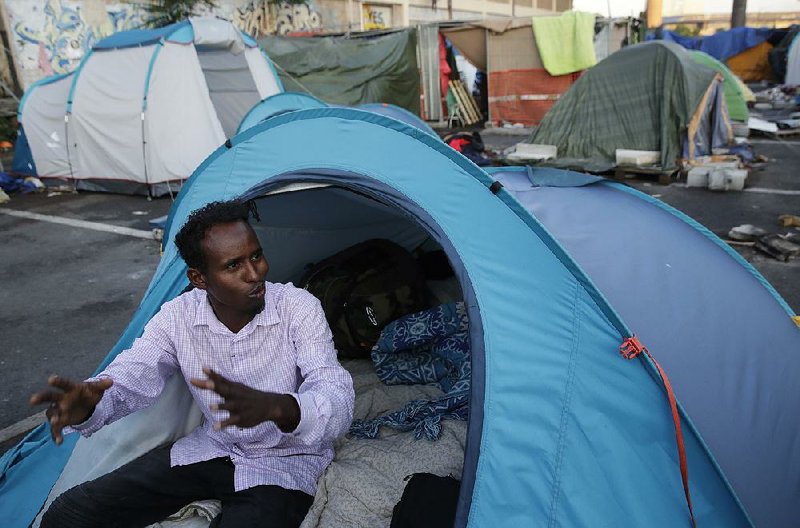ROME -- Barely a week in office, Italy's populist interior minister lost no time in driving home his message: His government will make good on a campaign pledge to swiftly deport 100,000 foreigners from the Mediterranean nation.
Standing next to two bus drivers who said they were assaulted by four foreigners -- one driver was still wearing a neck brace -- Interior Minister Matteo Salvini boasted to reporters in the lakeside town of Como that the four "fake asylum-seekers," whose bids for asylum had been rejected, would be rapidly deported back to Gambia and Nigeria.
"These guys won't be taking the bus in Como anymore," Salvini vowed.
Salvini also said that Malta should allow a Dutch-flagged rescue ship carrying hundreds of migrants rescued from rubber dinghies off the Libyan coast to make port there because the ship is now in Maltese waters.
"We ask humanly and politically that Malta finally opens one of its ports and lets these desperate people disembark," and then seize the ship, Salvini said.
Malta responded that it would "act according to the laws and applicable conventions." It offered no further explanation. International law states that Malta must respond if it is the nearest safe port at rescue or if requested by the ship's captain.
Salvini on Thursday said he would not allow the ship operated by the German NGO Mission Lifeline to enter Italian ports, saying that it had acted improperly by taking on board the 224 migrants that the Italian coast guard had assigned to the Libyan coast guard to rescue. Salvini said the rescue was in Libyan waters, which Lifeline denies.
Mission Lifeline said Friday that it still has not been assigned a port, despite its requests. It said it picked up additional migrant passengers during another rescue overnight, and was heading north with 234 on board. It said it had responded to a request for help by a merchant vessel to help rescue 113 people.
Italy's new government also turned away a separate rescue boat with hundreds of migrants aboard from its ports earlier this month, a pointed move signaling that the country has had enough of coping with the migrant influx arriving on European shores. Salvini has quickly proclaimed his next urgent mission: kicking out the large numbers of migrants already there.
Thanks to complicated bureaucracy, a lack of diplomatic agreements with the refugees' homelands and unwillingness of impoverished countries to take back their citizens, most of those who have lost asylum bids have so far run little chance of being deported from Italy.
Salvini is determined to reverse those odds.
"Over the next weeks, we'll start working on increasing expulsions," Salvini said at a rally earlier this week of his right-wing League supporters, who often blame migrants for crime or say they rob Italians of jobs.
Experts on asylum are skeptical that Salvini can achieve his ambitious expulsions target.
"I think that it's understandable that the government will want to try and make this move, but the numbers that have been floated by Mr. Salvini are going to be very difficult to achieve," said Federico Soda, who oversees the situation in the Mediterranean at the U.N.'s International Organization for Migration.
Some 600,000 migrants from dozens of countries have landed in Italy in the past few years after being rescued at sea. Except for those who managed to elude fingerprinting at dockside and slip northward into other European countries to claim asylum there, the vast majority filed asylum requests in Italy.
The Interior Ministry said that as of June 15, 133,815 requests for asylum were pending. So far this year, and in 2017, roughly 60 percent of those seeking asylum failed to receive any kind of protection, such as refugee status or humanitarian residency permits, the ministry said. That percentage included migrants who could no longer be found when a final decision was made. Such migrants are probably impossible to expel.
Those familiar with Italy's asylum and expulsion workings estimate that as many as 150,000 migrants could be awaiting expulsion.
According to European Union statistics, 7,045 migrants were expelled last year by Italy.
At that rate, it could take decades just to kick out all the migrants who have already been issued expulsion orders. That's not counting the many migrants who arrived legally but haven't had their permits renewed.
Yet the Italian government has formal expulsion agreements with just four countries: Egypt, Morocco, Nigeria and Tunisia.
Soda noted that more than 18,000 Nigerians reached Italy by sea in 2017, making up the largest number of asylum-seekers there. But overall, Nigerians represented just some 15 percent of the total sea arrivals that year.
Information for this article was contributed by Colleen Barry, Simone Somekh and Paolo Santalucia of The Associated Press.
A Section on 06/23/2018
